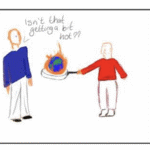-Credit:Jake Lindley / Manchester Evening News
On Saturday, 22nd February, tragedy struck in Manchester city centre when a Metrolink tram collided with a van at around 10am, resulting in the death of 3-year-old Louisa (Lulu) Palmisano.
The van had dangerously pulled out in front of the tram, which was unable to stop in time. The force of the collision caused the van to mount the pavement, where it struck Louisa, who was enjoying a weekend visit with her parents. Emergency services responded rapidly, including two air ambulances. Louisa was rushed to hospital, but tragically, she died of her injuries shortly after.
Following the incident, the van driver fled the scene. He was later identified as 35-year-old Rawal Rehman and appeared at Manchester Magistrates’ Court on Wednesday, 26th February, charged with causing death by dangerous driving.
Louisa’s death has shaken the city—and raised urgent questions. Could more be done to prevent tragedies like this from happening again?
Many of Manchester’s tram lines run through busy streets also shared by cars and pedestrians, creating spaces where one brief lapse in concentration can turn deadly. Though trams operate at reduced speeds (10–20 mph) in the city centre, the lack of protective infrastructure—such as physical barriers, dedicated tram lanes, or enhanced traffic signals—means that cars and people often interact dangerously close to the tram system.
While incidents like these are rare, each one has irreversible consequences. The emotional toll, the loss of life, and the trauma to witnesses and families ripple far beyond a single moment of impact.
Yes, altering road layouts, installing barriers, or redesigning crossings might add cost, congestion, and complexity to city traffic. But we must ask: What is the cost of doing nothing? What value do we place on a single human life—on a young child enjoying a family day out?
Louisa Palmisano should have gone home with her parents that day. Instead, her name now joins a list of preventable losses that call for urgent change—not just in Manchester, but in cities across the world where public transport and traffic share the same space.









